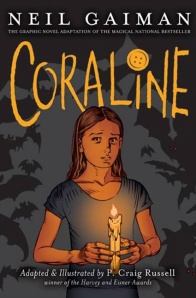Even though some distinctions in this format seem intuitive, I investigated the differences so I could be sure.
What is a graphic novel?
Graphic novels are books in which the narrative is conveyed with sequential art [which is the term used to indicate multiple images (often combined with text) arranged in sequence next to each other in time and space to form a story]. In other words, graphic novels are basically long comic books. Comic books rarely exceed thirty pages, but graphic novels can be any length. Moreover, historically, comic books have come out on a monthly basis with a continuing story, but most graphic novels just tell a single story that is complete within its pages. The length of the graphic novel allows it to present stories of greater intricacy and profundity than can a comic book.
Graphic novels are “hot, hot, hot.” Library Journal reports:
“Now, more than ever, graphic novels are the air pop culture breathes, providing the source material for today’s biggest events in film, TV, online/digital content, and publishing in general, as sequential art steadily infiltrates the literary and academic worlds.”
What is a comic book?
A comic book is a staple bound book or magazine that tells a story using sequential art (see definition, above). Word balloons and thought balloons are also often a part of the sequential art of both comics and graphic novels. Comic books rarely exceed thirty pages. Often stories are serialized, so that readers must continue to buy subsequent issues to find out what happens next.
Popular comic series are often bound together into volumes.
What is manga?
Japanese comics are called manga. The word “manga” (pronounced like Mahn-ga, with a hard g) is Japanese for “random or whimsical pictures.” They usually are serialized and are made in both the comic book and graphic novel format. Traditionally, manga are written from top to bottom and right to left, as this is the reading pattern of the Japanese written language (unless changed by the publisher when coming to America). Most mangas are completely black and white (with the exception of the cover art). They tend to feature two-dimensional drawings, characters with large eyes, and hair of abnormal size and color, and they are about some sort of conflict. Emotions are shown more often by using symbols (such as drops of sweat for worry) than by words.
“Manga” should not to be confused with “anime” (pronounced “ah-knee-may”), which is the Japanese term used for any animation. (The word anime is an abbreviation of the word animation.) Manga are often used as the basis for anime, but not every anime is from a manga and most manga are never made into anime. But they share certain features, such as similarities in the way the facial characteristics are exaggerated and the fact that stories are told in serial form, whereas, in American cartoons, they are told episodically.
Interestingly, a growing genre within manga is food manga. These comics involve food wars, wars between chefs, time-traveling chefs, and culinary skills as a weapon. You can listen to a feature on NPR on the food manga craze here.
The New York Public Library points out in the excellent “Beginner’s Guide to Manga” that there are basically five types of manga:
1. Shonen: Manga targeted at tween and teen boys.
2. Shojo: Manga targeted at tween and teen girls. (See this blog post for more insight into Shojo themes)
3. Seinen: Manga targeted at adult men (18+).
4. Josei: Manga targeted at adult women (18+).
5. Kodomomuke: Manga targeted at young children.
They also fill you in on Mecha, a genre of Japanese manga and anime that heavily features or focuses on mechanical innovation. (Think of robots, cyborgs, androids, and space stations, for example.)
You can find a list of “The Best Mecha Manga of All Time” here.












Ever the font of information, you are! I get frustrated when I go looking for graphic novels in a bookstore. They are usually lumped in with the comic books, and definitely are not given priority. GNs are definitely an underappreciated medium.
Sandy,
Agreed! My bookstore doesn’t know quite what to do with them either!
“The length of the graphic novel allows it to present stories of greater intricacy and profundity than can a comic book.” I actually disagree with this, even because many comic books are chapters in a larger plot arch that is later compiled and published as a graphic novel. So the length of the single issue doesn’t really tell us much about the profundity of the overall story. I do agree that all these terms can be confusing, though! To me (and to many comics critics like Douglas Wolk or Scott McCloud), the term “comic”, imperfect though it is, refers to the medium as a whole. Length doesn’t really play a role in it. Which is why I tend to get on my soapbox when I hear that graphic novels are better, more complex, deeper or more “grown up” than mere “comics”. Apologies in advance, and please don’t take my rant personally 😛 It’s not directed at your very informative post.
Well, you know honestly, the “book” Yummy is only about as long as a “comic book” so I suspect the standard definitions even now are morphing. I think Douglas Wolk uses the term “comics” to refer to books like “Maus” that many would classify as “graphic novels.” I suppose it’s one of those things where, if you get four people in a room, you end up with five definitions of comics versus graphic novels!
Great post!!! I’m probably using the wrong terms all of the time!
“Hair of abnormal size and color.” Ha- love it 🙂 I think I make the manga/anime mistake to a certain extent as when I read that line, I thought immediately of Howl in the anime version of Howl’s Moving Castle.
I tend to think of comics as what I read as a kid…Richie Rich, and the Archie series. Definitely more like a magazine.
You know, for the longest time I had the most difficult time distinguishing between these three types of books. I get it now, but I think I only understand it through the multiple tutelage of my kids, the blogs, and Wikipedia. I should have just waited for this post!
well…as popular as these genre seem to be with many bloggers, I can’t say I read any of the three.
That was a nice thorough definition! I always think of Archie (like Softdrink) when I think of comics too. 🙂 The only Manga I’ve read is the Emma series, and it did take me a while to get used to reading from front to back, left to right.
The bookstores here usually put the graphic novels and manga together and it’s hard to weed through all the manga to find the graphic novels.
Thanks for the info! I’ve wanted to learn more about these differences for a while now as it seems that not very many librarians are knowledgeable about their graphic novel collections. (Not in my library system anyway)
Fun to read this, as I just downloaded a CSI Interns graphic novel/manga (the only thing I’m sure of is that it’s not a comic book!) from the library.
I like all 3 genres big time and I certainly never thought that I would like Manga but I do!!
I’m never sure that differentiating between comics and graphic novels works — there are always so many things on the borderlines! I’ve given up and started using the terms interchangeably. I start to worry that I say “graphic novel” when I want to say an impressive version of “comic” though. :p
This is an interesting/informative post! My sister is much more into this whole business than I am…I hate pictures ha!
Thanks, Jill… this is a great post. I never was quite sure about manga.
Thank you for answering this question! Now if you can explain steampunk to me, I’d really appreciate it.
Have you read manga yet? I sure would be curious what you would recommend — there are so many of them at the bookstore that I don’t know what to try first. I like GNs, and also have been enjoying the Fables series which are issued as comics first (but am not too familiar with other comics yet).
Nice definitions, but I’ve honestly read some manga that have some intricate and detailed art that does indeed put the majority of it to shame. Just check out a series like Berserk, which has been in publication since 1989-90 and is only on its 34 volume because the author takes so long to make every panel as detailed – and realistic – as possible (so not a lot of crazy manga/anime cliches), unlike some other series that are released weekly and have the art equivalence of a a coloring book.
But I read all three formats. ^_^